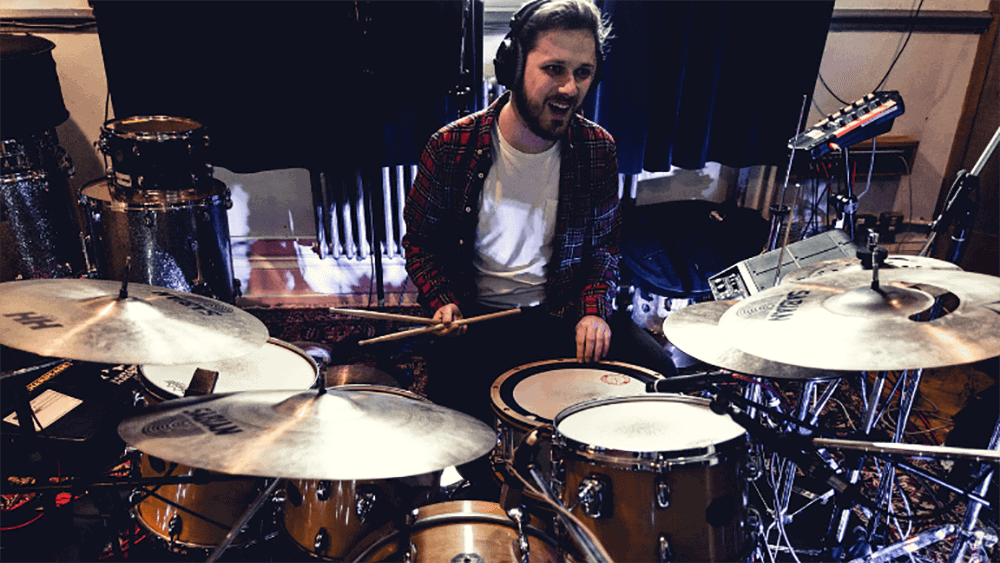JOIN US SEPTEMBER 2024 - APPLY TODAY OR BOOK YOUR PLACE ON ONE OF OUR OPEN DAYS IN BRIGHTON OR SHEFFIELD
JOIN US SEPTEMBER 2024 - APPLY TODAY OR BOOK YOUR PLACE ON ONE OF OUR OPEN DAYS IN BRIGHTON OR SHEFFIELD

My journey with Hybrid drumming started early in my life as a drummer. Perhaps even due to my strange introduction to drumming. It’s a long story, so put the kettle on, make a brew and get a load of this.
Believe it or not, the birth of my life as drummer started on the football pitch. My best friend at the time was eating his lunch, whilst I was training with the school team, and he was rudely interrupted by my throaty angry shout. Probably because someone wasn’t tracking back – wingers, eh?!. Anyway, when I finished up, and started walking back to the changing rooms, he came straight up to me and said “James! Do you like metal because you HAVE to join my band as a vocalist?!”. Being young (and stupid) I agreed. After many (terrible) rehearsals, with my just aimless shouting in the general direction of a microphone, we built a set and started doing some gigs. I know, I did this in public. (I’m not saying screaming/playing metal is embarrassing, I’m just saying that when I’m the one doing it, it is both those things and then some).
So why am I telling you this? Well, this was the start of my drumming career, I just didn’t know it yet. Every rehearsal, every sound check, the moment the drummer left that drum throne, I would run over and start playing. I would copy whatever the verse/chorus part of our songs I liked, and for some unexplainable reason, I could just play it. After a few months of doing this, it came to the day of a school concert for the new Music GCSE students, I was one of them. I did my classic pre-sound check bash around. My teacher at the time, who begged me not to take music (especially as a singer), poked his head from behind the sound desk and said “James, you didn’t tell me you played drums?”. “I don’t” I scoffed.
My yearning to be a singer carried on for 2 more years. In this time, I gained an obsession with James Hetfield from Metallica and set out to be him. Before you ask, yes, I bought an explorer (copy), yes, it’s black, yes, it has a faux chrome diamond plate top and yes, I still own it. So GSCE music was finished, and I did listen to Mr Marks. I played a grade 5 drum piece in my practical exam, which the drummer from my terrible first band, had to teach me because I could only learn by ear. I dropped out of sixth form in the first 2 weeks and enrolled at my local music college. For some unknown reason, I wanted to be a singer STILL, but the college only had space for a drummer. I lied and said that I was one and got stuck in. (I know I am one, but we’re getting there). So, I graduated music college, it was announced we were taking a family move to the Isle of Wight, and suddenly my plan to be a metal vocalist (despite spending two years studying as a drummer) was in question.
It was the middle of summer, I had no plans, but my mum was adamant I should contact the local music university, Platform One and see if there’s any space. So, I call and the gentleman at the end of the phone says, “you could be the luckiest student on the planet, someone dropped out this year’s course 20 minutes ago”. I go to my audition, wanting to be a singer, and I’m again told “we haven’t got any space for vocalists, but you mentioned you play a bit of drums?”. I agree and play along to a selection of songs he put through the PA and I was suddenly studying a Commercial Music degree, as a ruddy drummer!
10 minutes into my first formal lesson with drum teacher, Rupert Brown, (Lighthouse Family, Cher, and various others) I was hooked. Gone was the desire to be James Hetfield II and now I was fully committed to drums. This brings me to the point of the story (finally). The 2-and-a-bit years I spent not wanting to be a drummer, meant that I was learning guitar, singing and playing a bit of keys. I wanted to make music. I got my formal drum education, and even ended up teaching drums at college too, so it’s safe to say I consider myself a drummer now! This brings me to hybrid drums.
As most drummers will tell you, you get obsessed by soundscapes. You build your palette of cymbals (mine are a Sabian HH), find the shell pack that speaks to you most and the snare that just defines your vibe as a player (I have a one-of-a-kind Morgan Davies birch 14in x 6.5in with chunky wood hoops). It just didn’t stop there for me.
I am one of the biggest vintage Gretsch drum kit lovers you’ll ever meet. I have one, it’s a late 70s Gretsch USA Maple Octagonal Badge with a mid-60s Gretsch Round Badge Jazzfest snare, and it was the first kit I bought, and I don’t think I’ll ever change it. Acoustic drums are a traditional/old technology and you shouldn’t fix what isn’t broken. In the same breath, I’m of the biggest “haters” of the modern acoustic drum sound, which is where hybrid comes in.
What I love about synthetic drums, is that they are what they are. A drum machine may have originally meant to sound like an acoustic drum kit, but fundamentally does not. Take the TR-808, that sounds NOTHING like an acoustic drum kit, but this is exactly the reason that I love it. It’s not an acoustic drum kit, it’s a digital one. It’s a completely different instrument!
In some sort of way, utilising electronic drums to me is almost my way of still saying “I’m not a drummer”, which isn’t true, of course. Thanks to using electronics, the statement has evolved to “I’m not a drummer, I am a musician”.
Whilst working for Roland, I have developed an unhealthy addiction to synthesisers. Which I love using in relation to your classic guitar band, or jazz band. It just adds this whole other texture, that acts as the perfect juxtaposition to the acoustic instruments involved in the track. A good example is the band I play in, Bledig. Hannah Boulton from the vocal course is in this band, so here’s a shameless plug to check it out. I started sticking a Roland SPD-SX next to me to play live, and initially I used it to run backing tracks, trigger loops, run a click track and of course, trigger electronic drum sounds, but there was a problem. I had a drum kit, a traditional 1 up, 2 down kit with 2 crashes, hi hat and ride, but with an SPD-SX plonked to my left. This is where the hybrid kit was born. I didn’t want to keep turning to a tiny box to play electronic sounds anymore. I wanted to be a drummer, flow around my kit and get all the sounds I wanted, so I started looking into triggers.
I bought a Roland KT-10, which is a weighted kick trigger, so I could have one acoustic bass drum and 1 electronic one. It also meant that I could do little mini gigs with just an SPD-SX and a KT-10, but that’s not what I wanted, but anything to not play Cajon, right?!. I then added some Roland RT-30HR/Roland RT-30K triggers, meaning I could play my acoustic drums and you’ll hear an electronic sound layered on top of it. This was fun, it meant I could put a fat 909 kick sound on top on my open-tuned jazzy bass drum and have this HUGE sound come out the PA. I would then layer sub drops onto my floor tom, which is still very satisfying now.
Now I had an SPD-SX, a KT-10, an RT-30HR and a RT-30K. This still wasn’t enough. It still felt like I had an acoustic kit, but with a couple of electronic elements sprinkled on the top. Introduce the Roland TM-6 Pro. The TM-6 Pro was the perfect addition to expanding the amount of “one shot” sounds within my kit to make it feel a bit more interleaved with my acoustic setup. I got a couple of Roland BT-1 bar triggers and took some pads from my electronic drum kit, a Roland TD-25KV, and suddenly I had loads of stuff to play with.
I play with a few artists now, and all of them require some sort of electronic setup. When I turn up to a Bledig session, the whole set was written on just kick, snare, hi-hats and ride, but the SPD-SX sits there to add a little texture. Hatton Manor, which is also with Hannah Boulton, I take the full hybrid setup, same with Child of Cecilia and Night House.
I’ll hold my hands up and admit, I don’t use the full hybrid kit for every gig, because of course each gig is unique in its requirement, and you should always take the necessary tools to the job. Though, having some sort of electronics to hand is a huge asset and adds to pretty much every job you may get as a drummer, so I usually bring at least the SPD-SX to a session. You only need to look at the major names in the session world and almost all of them use an SPD-SX. It’s gotten me way more work anyway...
One thing that was very fun was playing in a live house music covers band. I would turn up to a gig with my SPD-SX, KT-10, a floor tom, my snare and my cymbals. That’s right, no bass drum! I wanted things to be more authentic, so almost all house tracks have either a TR-909 or TR-808 in them and no acoustic drums. The nature of the genre is in the production, and it was all performed/made by cutting up samples and syncing up hardware synths/sequencers/drum machines. I could find samples of these old drum machines, or just take it straight from the track, load it into my SPD-SX, and go play it live.
There are loads of ways to start looking into incorporating hybrid drums into your setup, you don’t have to go as ambitious as I am. The range of products out there is staggering, and I’ll admit somewhat overwhelming, but here’s a couple of ideas to maybe get you started. An SPD-SX is a very powerful tool, it almost does everything, but most first-time buyers can’t really afford it, which is fine. You could go for a single pad version from the SPD::ONE range, which has the Kick, Percussion, and Electro. These are tiny little boxes that have one pad and load of onboard sounds. You can even load in one of your own samples. If you want to load more samples in, or start triggering backing tracks, you could look at the SPD::One Wav.
Your other option is to investigate adding a couple of triggers into your setup and layering some electronic sounds over your acoustic drums. That’s where the TM-1, TM-2 or TM-6 Pro Trigger Modules come in. You could then get a couple of the RT-30 triggers, or maybe more, like the BT-1 or taking pads from an electric kit you already own.
Either way, I love chatting hybrid, and with my job as a Product Specialist with Roland, I get to talk about it almost every day. Not only do I help people setup their hybrid kit, I help keyboard players with their synthesiser/keyboard rig, guitarists build a pedalboard and piano players find the perfect way to practice. You could say that I get to use all my failed experience as a non-drummer, but in a different way! If you’re struggling to get your perfect gigging/studio setup, feel free to get in touch!

- ‘Water bear’ is the common name for a Tardigrade.
- Tardigrades are micro creatures, found everywhere on earth.
- They are the most resilient creatures known.
- They can survive and adapt to their surroundings, even in outer space.
- Their resilience and ability to adapt and survive inspires us in everything we do. We love them.


WaterBear Education Ltd, Hanover House,
118 Queens Road, Brighton BN1 3XG, UK Map
Email: [email protected]
Tel: +44 (0) 1273 726230
WaterBear Sheffield, Unit 4, Gatecrasher,
49 Eyre Lane, Sheffield S1 4RB, UK
Email: [email protected]
Tel: +44 (0) 1143 992720

WaterBear Education Ltd, Hanover House,
118 Queens Road, Brighton BN1 3XG, UK Map
Email: [email protected]
Tel: +44 (0) 1273 726230
WaterBear Sheffield, Unit 4, Gatecrasher,
49 Eyre Lane, Sheffield S1 4RB, UK
Email: [email protected]
Tel: +44 (0) 1143 992720
- ‘Water bear’ is the common name for a Tardigrade.
- Tardigrades are micro creatures, found everywhere on earth.
- They are the most resilient creatures known.
- They can survive and adapt to their surroundings, even in outer space.
- Their resilience and ability to adapt and survive inspires us in everything we do. We love them.
